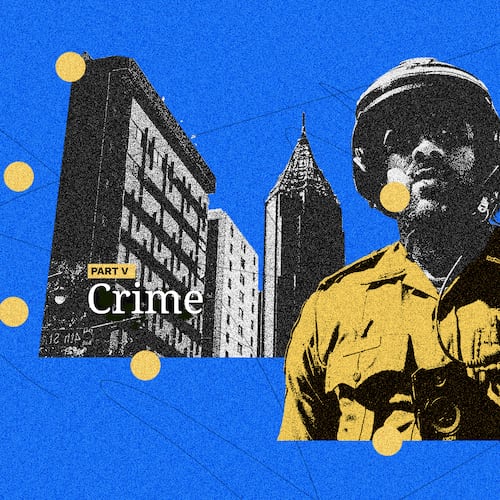LAGRANGE — The police officers’ voices grew firm and loud as they pointed their guns at the human silhouettes in the distance.
“Sir, drop the sword, drop the sword,” one officer yelled.
“Drop it, drop it,” another hollered.
Does the officer shoot or not? If an officer must shoot, is there a way to lessen the chance of death? These questions hung over the training that played out days ago at LaGrange Police Department’s gun range. But some version of these scenarios unfolds for real across America daily as police engage with individuals who are sometimes armed and erratic, posing a threat to officers or the public.
The training is part of a new program launched by the West Georgia agency meant to address some of these questions. The program, called “Shoot to Incapacitate,” is challenging decades of police orthodoxy around use of deadly force. Instead of teaching officers to always aim for available center mass of the body — usually the chest, upper torso and head — the training is giving them another option if they must fire their weapons in the line of duty.
The course is the first of its kind in Georgia and could well be a first in the nation. It teaches officers that in some instances where they are authorized to use deadly force, they have the option to aim for the pelvic region, abdomen, legs and arms of a person posing a threat. The idea is that a gunshot to these areas, while still potentially deadly, could stop the threat while increasing the chance that the wounds will not be fatal.
It is a break from generations of American law enforcement training taught in academies and in annual recertification training. The reason officers have been instructed to aim for the upper torso and head area is that it generally provides the largest target and the fastest way to stop the threat.
This method, while effective, has contributed to the roughly 1,000 fatal police shootings each year and helped plunge law enforcement agencies, and the communities they serve, into crisis after crisis. About a quarter of the fatal shootings each year occur in situations involving the mentally ill, sometimes at the height of a breakdown or episode.
Credit: Curtis Compton / Curtis.Compton@
Credit: Curtis Compton / Curtis.Compton@
“It’s a responsibility, in my opinion, of any police leader to look at options for their police officers so that a deadly force encounter doesn’t necessarily end in a deadly result,” said LaGrange Police Chief Lou Dekmar.
The training, launched in February, has already sparked debate and questions. It comes as police officers across the country feel besieged by public scrutiny and second guessing unlike anything the profession has seen its history. Some LaGrange officers viewed the course initially with a dose of skepticism.
“To be honest, when Chief Dekmar called me and we sat down and talked about it, that was my first reaction,” said Sgt. Joshua Clower, the department’s training director. “I was like, ‘I don’t know about this.’”
Clower said he changed his mind as he researched the issue to develop the training. He looked at dozens of police shooting videos and consulted with medical experts. The training includes a classroom session that lasts more than an hour, with a discussion of how the technique could apply to several actual cases, including the 2017 shooting death of a Georgia Tech student armed only with a multi-tool. Officers also undergo subsequent firing range sessions where they walk through various scenarios where the technique can be deployed in the field.
“I worked on the street as a patrol officer for 17 years,” Clower said. “You find yourself in situations where the use of deadly force is justified, but I really don’t want to take this subject’s life.”
He said the program hasn’t replaced the agency’s focus on de-escalation and less lethal options. The training instruction emphasizes the shoot to incapacitate method can only be used if deadly force is justified. It doesn’t supplant the option to aim for the chest or head if a suspect has a gun or officers’ judgment deems those targets necessary to ensure safety for themselves or others.
After some initial reluctance and skepticism, the overall feedback has been positive in anonymous surveys by officers in the department who completed the training, Clower said.
“Our folks are going to question things that may not make sense,” he said.
Credit: Curtis Compton / Curtis.Compton@
Credit: Curtis Compton / Curtis.Compton@
Other agencies and police professionals are taking note. Some see Dekmar and his agency playing into the hands of activists and others pressuring police to reform in ways that could compromise the safety of officers or the general public. Some wonder if its stated goal of preserving life is realistic. Others see the training as the type of creative thinking that could hold promise, while still wanting more data before making a final judgment.
Park City (Utah) Chief Wade Carpenter, who heads the International Association of Chiefs of Police firearms committee, was in Georgia recently to take measure of the new training. He said he expects it to spur discussion as police leaders grapple with the ongoing need to change and evolve.
“I think early on, until they do their own trials and tests, they’re going to be skeptical,” Carpenter said. “I’m in that same boat. That’s why I’m here today because I want to see firsthand what the concept is and see if it’s a a viable option.”
Chief initially reluctant
Dekmar didn’t come to the idea overnight.
His law enforcement career has spanned more than four decades, including the past quarter century leading the LaGrange department, about 67 miles southwest of Atlanta. During that time, his officers fired their guns in 13 deadly force incidents, including two that resulted in death.
While other agencies prohibit using warning shots, Dekmar has kept it as an option for officers.
“I worked on the street as a patrol officer for 17 years. You find yourself in situations where the use of deadly force is justified, but I really don't want to take this subject's life."
Warning shots have only been used once during his tenure, but the technique had a significant impact for one family.
“To the 15-year-old that we didn’t shoot and kill when we were lawfully justified, that made a significant difference,” he said.
Dekmar said he first learned about the shoot to incapacitate concept 17 years ago in a police exchange program with Israel. He later learned that countries in Europe use a similar approach.
“It became increasingly clear that many nations train their officers to shoot to incapacitate, if that’s possible,” he said.
At first, he wasn’t sold on the technique.
“It took me a period of time to process it and adjust to it,” he said.
In 2019, he introduced the concept to his firearms instructors and asked them to think about it. Last year, the agency leaders researched the issue and couldn’t find any other agency in the U.S. using the strategy. They developed their own protocol, and Dekmar approved the training and range procedures that were incorporated into the agency’s annual training that started in February.
He said when the public calls police for help, they expect officers to show up with alternatives and knowledge of how to deal with a situation. His officers are trained for verbal de-escalation and crisis intervention methods, as well as less lethal options such as Tasers, 12-gauge beanbags, pepper balls and BolaWrap remote restraints. He views shoot to incapacitate as a tool he hopes his officers will rarely use, but one that is there if use of deadly force is justified and necessary.
“Anytime you can preserve a life, what that does is earn trust and maintain confidence of the public, which is absolutely necessary if you’re going to be effective in the entire arena of public safety,” he said.
Credit: Curtis Compton / Curtis.Compton@
Credit: Curtis Compton / Curtis.Compton@
The unorthodox training isn’t the first time Dekmar has made waves among his colleagues.
In January 2017, he made national news when he became the one of the first police chiefs in the South to apologize for his agency’s role in the lynching of a Black man. Even though the crime had occurred more than 70 years ago, Dekmar, who is white, believed its legacy still impacted the community’s view of his agency and its officers. As president of IACP in 2017 and 2018, he urged other police leaders to repair the broken trust with minorities in their communities. He also called for an improvement in policies and training to handle mentally ill people.
‘Definitely doable’
At the range training last week, Sgt. Clower was directing officers through different real world scenarios where the shoot to incapacitate concept might be an option.
At one end of the range, the human silhouettes were positioned with body sections that are color coded to indicate desired target areas. The pelvic area, thighs, legs and arms were green or yellow — indicating desired spots to aim. The chest, upper torso, head and neck were shaded in red — indicating areas to try to avoid.
The officers took positions 15 yards, seven yards and three yards away from the targets. Clower used a whistle to signal the point in the training scenario where deadly force was justified, which was followed by a series of gunshots by the officers. In most cases, the bullets struck the green area that marked the pelvis and thigh areas, which the training emphasizes because they carry more mass than the arms and lower legs.
In one scenario, at close range, the officers were told to aim for the red area because the close proximity of their suspect placed the officers at increased risk.
Corporal Robbie Hall said the training went better than he expected. He said there has been concern among some colleagues that the technique won’t work or will place officers at risk. The training, he said, offers another option if use of force is necessary. Under the tactic, officers must assess whether the situation and distance make it a viable alternative.
“Before I shot this target, it didn’t seem like an option,” he said. “It’s definitely doable. Now that I actually went through the course, it’s doable.”
Credit: Curtis Compton / Curtis.Compton@
Credit: Curtis Compton / Curtis.Compton@
Still, some in the broader law enforcement community wonder if LaGrange is headed down a thorny path, according to interviews by the AJC. They worry that the training could create community expectations and raise questions about why officers didn’t employ the tactic in all police shootings. They also question how realistic it is in live situations to hit a moving target and stop a lethal threat while also firing a gun with the precision to wound, but not kill.
The LaGrange program appears to be part of an effort by agencies nationwide grappling with ways to stop deadly threats while increasing the survivability chances of suspects, said Von Kliem, a policy attorney with the Force Science Institute, a company that studies police and community violence.
“Before I shot this target, it didn't seem like an option. It's definitely doable. Now that I've actually went through the course, it's doable."
Kliem, a former police officer, said some agencies in recent years have turned to controversial policies that allow officers to use Tasers against knife-wielding suspects, as long as they have deadly force options available. He said that with any luck, the shoot to incapacitate policy will work in the rare instances where it would be appropriate.
“To say these tactics are authorized is not to say these tactics should be considered in most cases,” he said. “The agencies, officers, and communities need to decide whether increased risk of death and serious bodily injury to the officers and the community members is worth these attempts to save suspects from the consequences of their deadly decisions.”
Activists in Georgia say reform of police use of force is long overdue. They point to scores of deadly police shootings with little accountability. They say more emphasis needs to be placed on de-escalation tactics and preserving life in police encounters.
“In this climate, we don’t need any more police shootings, period,” said Gerald Griggs, an attorney and activist who has worked on police reform with the Georgia NAACP. “We need to reevaluate how we deal with all of that.”
Dekmar views the debate to be critical as community standards and expectations evolve.
“I think what the community expects is that we need to be wise,” he said. “The standard isn’t “awful but lawful”. The standard is -- under the facts and circumstances -- did the police realistically do all they could do to preserve life in a situation. We’re supposed to be the professionals. We have to be reacting with more than one alternative, which is shoot center mass — particularly if we can do so safely.”
About the Author
The Latest
Featured






